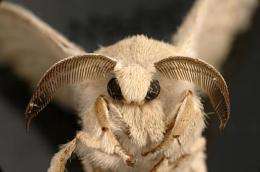A new twist in the sex life of silk worms

(PhysOrg.com) -- A quirk in the sex life of the silkworm (Bombyx mori) has been revealed by a team of CSIRO Food Futures Flagship scientists led by Dr Alisha Anderson.
While researching insect odour receptors as part of a project to develop a handheld biosensor device, Dr Anderson and her collaborators at HortResearch in New Zealand and the University of Illinois in the USA, discovered an intriguing puzzle when working backwards from the moth’s genes to its anatomy.
“When we looked at the genome of the silkworm we found genes that encode odour receptors, some of which only appear in the antennae of adult females,” Dr Anderson said.
“We made some of these receptors in the lab and looked at what chemicals they responded to. The results puzzled us as the chemicals looked similar to the male pheromones found in other species, but there was no information that silkworm males produced a pheromone. So we appeared to have receptors for a male pheromone but no evidence that male silkworms produced one.”
In other insects, structures called ‘hair pencils’ are known to be involved in the release of male pheromones, so the group, in collaboration with a French scientist, went looking for hair pencils in male silkworms.
“And we found them,” Dr Anderson said. “However, we haven't yet shown that male silkworms actually release a pheromone. It is possible that over thousands of years of domestication they have lost the capacity to do so. Another possibility is that the receptors are used to help the females identify good oviposition sites. Some of the chemicals involved are found in both plants and male pheromones.”
She said the research shows it is possible to work backwards from genes to anatomy and maybe even behaviour.
The silkworm research is part of a larger project to develop a handheld biosensor, the Cybernose, for detecting odours in wines. Using insect receptors, the cybernose would detect volatiles and contaminants in grapes and wine, thus allowing winemakers to improve their wines. When completed, the Cybernose will have even wider application for detecting ripeness and spoilage in a range of foods, and even applications in detecting explosives.
The research was made possible by the recent publication by Chinese and Japanese scientists of the genome of the silkworm. Dr Anderson’s work was part of the process of ‘annotating’ the genome or working out which genes do what.
Provided by CSIRO (news : web)

















